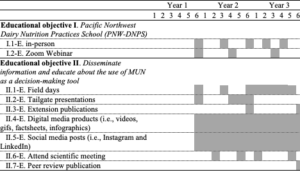Progress report for SW24-009
Project Information
Dairy operations face increasing concerns about environmental pollution caused by nitrogen excretion from dairy cattle. The mitigation of the environmental impact associated with dairy farming can be achieved by ensuring that cows receive an appropriate amount of protein for efficient milk production. Milk urea nitrogen (MUN) is a valuable tool for monitoring dietary protein and nitrogen excretion. However, the interpretation of MUN values is constrained by its high variability, which is attributed to a wide range of factors that are not comprehensively elucidated. This proposal aims to refine the use of MUN as a decision-making tool to enhance nitrogen utilization efficiency in dairy cows and reduce the environmental impact of dairy farming. We will collect data over two years from three dairy farms in Idaho and one in Utah to determine the relationships between MUN and animal characteristics, production, and diet composition. Subsequently, we will derive computer-assisted mathematical models to relate MUN and animal, production, and diet parameters. Our study will also quantify how changes in MUN are associated with economic and environmental outcomes. To evaluate the impact of environmental factors, such as heat stress and wildfire smoke, on MUN variability, controlled experiments will be conducted over two years at the University of Idaho Dairy Center. Our educational plan includes implementing the Pacific Northwest Dairy Nutrition Practices School (PNW-DNPS) to educate producers, nutritionists, feeders, mid-herd managers, students, and other professionals about the importance of good feeding management practices for delivering an effective nutrition program. Furthermore, we will disseminate information about using MUN as a decision-making tool through traditional outreach methods and various media formats, targeting professionals involved in dairy nutrition and advising producers. To facilitate the practical application of our research, we will develop a user-friendly web-based tool called MUNTune, which integrates the derived equations to monitor MUN on dairy farms. Model adequacy will be evaluated using an independent database from published studies. By refining the use of MUN as a decision-making tool, dairy farmers can enhance nutrient utilization, reduce environmental impact, and promote the long-term viability of dairy farming practices. This proposal will contribute to the sustainability of the dairy industry by improving protein efficiency, achieving cost savings, and reducing nitrogen excretion.
1) Derive MUN equations based on on-farm data and quantify economic effects on MUN of varying animal, production, and diet characteristics; 2) Evaluate the effect of the environment on the variability of MUN in dairy cows; 3) Develop and deliver the Pacific Northwest Dairy Nutrition Practices School (PNW-DNPS); 4) Disseminate information and educate the public about the use of MUN as a decision-making tool to enhance nitrogen efficiency of dairy cows; 5) Develop a mobile-friendly web-based tool (MUNTune) for producers and nutritionists to help them monitor the diet of dairy cows, given their site-specific characteristics.
The overall structure of the project timeline (that is, the planned activities for Years 1, 2, and 3) remains unchanged. However, due to the 2024 avian influenza (H5N1, bird flu) outbreak, Western SARE approved a postponement of the project start date. The project contract officially commenced on August 1, 2025. Nevertheless, initial project activities were delayed because producers remained cautious about on-farm visits throughout August, September, and early October.
As a result, the first in-person activities, such as the initial dairy visit to gather general information, establish and discuss the sampling routine with collaborating producers, and meet key dairy personnel who will interact with the project team on a monthly basis, did not occur until the end of October 2025. On-farm sampling officially began during the first week of November 2025.
Due to this delay, the start of the activities related to the educational objectives was also postponed. Educational Objective I is scheduled to start at the end of Year 1 (end of Summer 2025), and Educational Objective II is set to begin end of April 2025. Although the start dates for these educational activities were postponed, all activities planned for Year 1 will still take place during that timeframe.
Cooperators
- - Producer
- - Producer
- - Producer
Research
Over the first months of the project, our research efforts have focused primarily on Objective I-R: deriving MUN equations based on on-farm data. The early phase of our project centered on developing sampling protocols and initiating sampling activities on cooperating dairy farms, as outlined below.
Activities conducted to date
Objective I-R: On-farm data collection and model development
We began sampling in November 2024. During this six-month sampling period, field teams have conducted monthly visits to the cooperating dairy farms. These visits have included:
- Collecting comprehensive animal data (breed, days in milk (DIM), parity), production data (milk production), and diet formulation details.
- Collecting bulk tank milk samples monthly, along with composite samples of total and partial mixed rations (TMR/PMR), forages, concentrates, robotic pellets (where applicable), and mineral/vitamin supplements.
- Collecting fecal and urine samples from randomly selected lactating cows for nitrogen and dry matter analyses.
Standardized sampling materials have been used to maintain sample integrity, including: containers for milk, feed, feces, and urine samples, and refrigeration units and freezers for proper storage of both composite and individual samples.
Our primary quantitative measurement for Objective I-R is MUN concentration. We are also collecting supplementary data on milk composition (fat, protein, lactose, somatic cell count) and the nutrient composition of feeds and diets (dry matter, protein fractions, carbohydrate fractions, starch). These analyses are conducted in commercial laboratories using validated, standardized methods.
Urine and fecal samples are analyzed in-house, also using validated and standardized methods. This decision was made due to the difficulty of finding commercial laboratories that perform the necessary analyses for these samples, and to build student capacity by exposing them to analytical methods (i.e. freeze-drying, nitrogen, among other).
All sampling and analyses follow standardized protocols to ensure comparability of data across farms and over time. To date, rigorous quality assurance protocols have been implemented during sample collection and data entry, with cross-checks against on-farm and lab records to ensure data consistency.
Although model derivation will occur after further data collection, preliminary data cleaning and descriptive analyses have confirmed the feasibility of our sampling protocols. These foundational activities support the future development of models linking MUN to production, nutrition, and nitrogen excretion.
Objective II-R: Evaluating environmental effects on MUN
Objective II-R focuses on assessing how environmental stressors (heat stress and wildfire smoke) affect MUN variability. Controlled experiments at the University of Idaho Dairy Center were planned and initiated in summer and fall 2024. However, no significant environmental challenges occurred during that period that could impact lactating cows performance and MUN values.
Despite this, we completed two sampling periods, in August and September 2024, which will serve as baseline data for the project. These preliminary samplings also allowed us to refine and finalize the experimental protocols and validate our methods. All protocols and necessary materials are in place for future sampling in 2025.
All sampling and analytical activities remain aligned with the project timeline. The six-month on-farm sampling period has established a strong data foundation for Objective I-R, while preparations for the controlled experiments under Objective II-R are progressing as planned. As the project advances, ongoing data collection will support model development and enable more in-depth quantitative analyses, which will be reported in future project periods.
Our preliminary results reflect progress on both research objectives and establish the foundation for subsequent modeling and interpretation.
Objective I-R: On-farm data collection and model development
To date, we have completed six months of on-farm sampling across cooperating dairy farms. On average, lactating cows were producing 77 ± 26.8 lbs of milk, were 209 ± 122.3 days in milk, and had an average parity number of 2.54 ± 1.46.
The table below summarizes descriptive statistics for milk composition, MUN concentrations, and nitrogen excreted in urine.
As preliminary results, we explored relationships between MUN and milk components. The figures below illustrate associations between MUN and milk protein, milk fat, and lactose concentrations. These data suggest that as MUN increases, milk protein decreases, whereas no clear relationships were observed between MUN and milk fat or lactose. These emerging patterns will inform future model development.
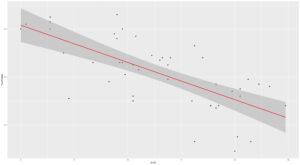
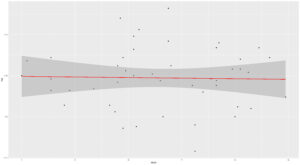
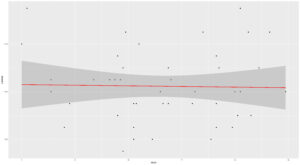
In addition, we examined the association between MUN and urinary nitrogen excretion. As shown in the figure below,urinary nitrogen concentration increases as MUN increases. Although preliminary, these results support the scientific rationale for using MUN as a proxy for nitrogen use efficiency on-farm.
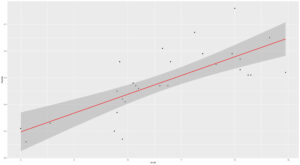
An additional observation across all dairies was a decline in MUN values in April 2025. While still under investigation, this trend may indicate an effect of environmental conditions, as no major changes in diet were reported during that period. This observation suggests potential interactions between environment and MUN that warrant further study.
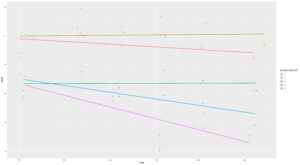
Objective II-R: Evaluating environmental effects on MUN
We sampled lactating cows in Moscow, ID at the end of summer and beginning of fall 2024. As no major environmental stressors (e.g., heat stress or wildfire smoke) occurred during this period, the data primarily served to test protocols and refine sampling logistics. Descriptive statistics from this sampling effort are presented below.
Table 2. Descriptive statistics for lactating cows in Northern Idaho during late summer and early fall 2024
Although no significant environmental challenges were present during this period, these data establish a baseline for comparison in 2025 with known environmental stressors. They will also support interpretation of within-animal variation in MUN and nitrogen excretion under different environmental conditions.
Research outcomes
Although our results are still preliminary, this project has begun to lay the groundwork for improving nitrogen use efficiency (NUE) in Western U.S. dairy systems. Early data collection efforts have shown promising patterns and relationships between milk urea nitrogen (MUN), milk composition, and nitrogen excretion in urine. These findings support the continued development of MUN as a potential on-farm indicator of NUE and environmental nitrogen losses.
Our preliminary results confirm the feasibility of collecting and interpreting MUN data on commercial farms. This supports its potential future use in helping producers make more informed decisions around dietary protein and nutrient management. In addition, the observed relationships between MUN and milk protein and urinary nitrogen highlight a pathway toward developing practical tools to improve nutrient efficiency and reduce environmental impact.
As data collection continues, we anticipate this project will contribute directly to the development of tools that support efficient feeding strategies, reduce nitrogen losses, and align with environmental stewardship goals in the region.
Ultimately, by building a science-based framework around MUN, this work may help dairy producers meet regulatory and market expectations related to nutrient management.
Education and Outreach
Participation summary:
The project start date was postponed to August 1, 2025, due to the avian influenza (H5N1) outbreak. Although the structure and goals of the educational objectives remain unchanged, the timing of their implementation was adjusted accordingly.
Educational Objective I – Pacific Northwest Dairy Nutrition Practices School (PNW-DNPS): this objective is scheduled to begin at the end of Year 1 (Summer 2025). Preparatory work has already begun, including a series of one-on-one discussions with cooperating producers, dairy employees, nutritionists, industry professionals, and other key stakeholders. These interactions have been aimed at identifying participating experts, outlining curriculum content, and updating instructional materials. Additionally, venue options and delivery formats (in-person and/or hybrid) are currently being evaluated to ensure effective participation from the target audience.
Educational Objective II – Dissemination and Education on MUN as a Decision-Making Tool: initial outreach and education activities under this objective are underway and are set to launch at the end of April 2025. Similar to Objective E-I, a series of one-on-one discussions with stakeholders and cooperating producers has been scheduled to determine the most effective tools and methods for disseminating the information. These discussions have also helped to shape the topics that will be disseminated during Year 1. Additional activities have included the development of communication materials (such as factsheets and posts), coordination with extension networks, and the preparation of supporting materials.
We have included a brief timeline summarizing the upcoming education and outreach activities for Years 1, 2, and 3. All planned activities for Year 1 will be completed within the adjusted project period.
As of the current reporting period, no measurable results are available yet, as the educational and outreach activities are still in the preparatory or early implementation phase. Initial engagement with stakeholders, such as one-on-one discussions with producers, nutritionists, and industry professionals, has provided valuable input to guide upcoming efforts. These conversations have informed the design of educational materials and delivery strategies, especially for reaching dairy professionals with a busy schedule.
Quantitative and qualitative findings will be reported in the next project period, following the implementation of educational objectives I and II in Summer 2025 and end of April 2025, respectively.
Education and Outreach Outcomes
Because the formal education and outreach activities have not yet commenced, we do not have measurable outcomes to report at this time.

